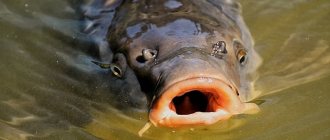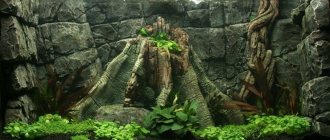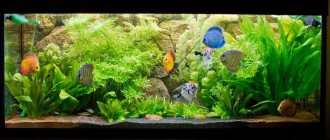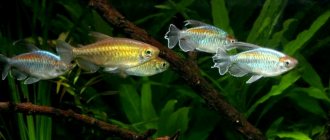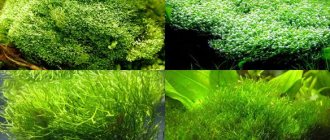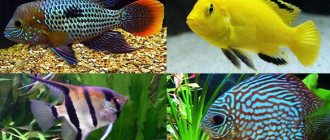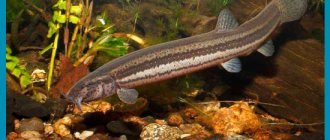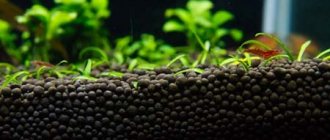Fish of the carp family can very often be found in the aquariums of both beginners and experienced aquarists. The main reasons for such a wide prevalence of cyprinids in our aquariums are their unpretentiousness, the huge variety of species of the family, and ease of care and maintenance. If you look at a beginner’s aquarium, you will probably find in it an elegant zebrafish or a nimble barb, a huge thick veiltail or an original colored rasbora - all these popular fish belong specifically to the carp family.
Some scientists estimate that there are about 2,000 species of fish belonging to this family in the world. Different scientists have different opinions about this, but one thing is certain - carp fish are extremely abundant in fresh water bodies around the world, and some species can even live in slightly brackish water. Most of the carp fish that are kept in aquariums naturally live in the tropics or subtropics. Despite this, they easily adapt to life in aquariums, and with proper care they reproduce easily. The answer to the question in which aquarium you can keep cyprinids will be clear - in almost any one . The only exceptions may be marine aquariums or those reservoirs that contain aggressive predatory fish species.
Carp family
A fish of the carp family, in most cases it is schooling, but, for example, labeos live quietly in a school until they grow up, then they begin to fight for territory. Aquarium carp fish are different from other species. They have a characteristic structure that cannot be confused with anyone else.
The submandibular bones are connected by the upper jaw, which makes it possible to move the mouth forward and downward. There are no teeth on the jaws, but there are pharyngeal teeth located on the pharyngeal bones in several rows. The body is laterally flattened, cycloid scales, some species have a naked body. Cyprinid fish either do not have antennae, or there are only 1-2 pairs of them. Almost all of them are heat-loving and omnivorous. Males are smaller than females, slimmer and brighter.
Origin
The carp fish family originated in the tropical Afro-Asian region. Barilia and three-lipped fish were the oldest genus of fish. They have been known since the Eocene period (60 million years ago).
The geography of the settlement of the carp family is quite extensive. They feel good in mountain rivers, among melting snow. Marinkas, Ottomans and Discognathus live there. Other species have adapted well to 35 degree heat, for example, carp, Indian catla, tsirrina-mrigal, some types of barbs, and many others. Tribolodon rudd splash in the waters of the Far East. The Pamir highlander has adapted to life at altitudes of up to 4500 m above sea level. The Altai dace also loves heights, but can only withstand a thousand meters. Groundwater has been taken over by: blind kekocypris, typhlogarra and kecobarbus. And such popular crucian carp and tench can withstand freezing of water covers, and wait out unfavorable conditions by burying themselves in silt.
Reproduction
Many species of cyprinids interbreed with each other, for example, barbs. This is used by breeders to breed hybrids that differ in their original appearance and color. But we must remember that these fish hunt their offspring, not to mention other species. Therefore, a separate spawning tank is a mandatory attribute.
During the mating season, they develop rashes or wart-like growths all over their bodies. You can stimulate spawning by replacing it with fresh and soft water, raising the temperature a couple of degrees and changing the light intensity.
The eggs of fish that live in northern waters develop slowly, so to speak in portions. Cyprinids mature at six months of age.
Although they are not very demanding on living conditions, certain conditions must be created for spawning. 2 weeks before spawning, the couple is separated and intensively fed. You can stimulate spawning by replacing the water with fresh and softer water, raising the temperature a couple of degrees, or changing the light intensity. Successful spawning depends on the activity of the pair. When spawning, cyprinids require more experience and effort than, for example, livebearers.
Spawning tanks are needed not high, but with a high bottom density. For small species, a ten-liter aquarium with a water level of 12-16 cm is sufficient. For large fish, you already need an aquarium for spawning with a large volume, 50-200 liters, depending on the size, with a water level of 20-45 cm.
The fry also require some care. Since the fish eat their eggs and fry, you need to lay a net on the bottom and plant a lot of plants so that the fry can hide in them. The amount of caviar can be many from 50 to hundreds of thousands of eggs. The larvae hatch after 1.5-2 days, and after 3 or 4 days they begin to swim and feed. The first food is paramecia, rotifers, nauplii of Cyclops, Artemia, and so on. For the development of the fry, it is important to feed small meals frequently.
Content
Various types of food are suitable for nutrition: dry, canned, frozen, live. They require spacious elongated aquariums. To make the fish more noticeable and more impressive, it is preferable to select dark soil and bright vegetation.
For keeping fish, the most comfortable water temperature is -22-24 °C, some species require up to 28; minor changes are possible.
Lighting - some species require additional lighting; otherwise, they fade and lose their beauty.
He loves to eat bloodworms and daphnia, and from the plant menu - various aquatic plants, lettuce, dandelions, dry food flakes.
Kinds
Popular carp fish for the aquarium:
- Aquarium fish barbs are fast and fussy. They are compatible with active fish of the same size or larger. Barbs are aggressive fish; they should not be kept with fish such as angelfish, gouramis, laliuses and the like; the fins will be bitten by the barbs. They feed on dry and live food. The optimal temperature for them is 20-25 degrees. There are more than 10 breeds of this species. Sumatran barbs are especially popular.
Aquaria2.RU
In the last issue of AQUARIUM MAGAZINE we talked about viviparous fish. This is an almost ideal population for a decorative aquarium, densely planted with live plants. Departing a little from the ideal, let's move on to fish of the carp family. From this, perhaps the largest family of freshwater fish, all kinds of danios (Danio and Brachidanio), cardinals (Tanichtys albonubis), rasboras (Rasbora), small species of barbs (Barbus titteya, etc.) and even some inhabitants of our domestic reservoirs that do not spoil the plants.
On the one hand, the choice of carp fish for a planted aquarium is much wider than that of viviparous fish. On the other hand, among the variety of cyprinids there are many species that are extremely undesirable in a planted aquarium. For example, having settled on barbs, you need to look very carefully at which types are suitable and which are not suitable under any circumstances. If there is not a single fish from the genus Rasbora that would spoil plants and harm a decorative aquarium, even among large species, then in the case of barbs the situation is completely different. In addition, fish that do not belong to this genus are traditionally sold under the trade name “Barbus”: Balantiocheilus melanopterus (“Shark Barb”), hampala (Hampala macrolepidota), Cyclocheilichtys sp., growing up to 50-100 cm and weighing 1 .5-2 kg, and is a commercial fish in its homeland, and other large species.
"Shark Baloo" (Balantiocheilus melanopterus) - too large a fish for a planted aquarium
The degree of “suitability” of certain types of barbs for an aquarium with plants depends not only (and often not so much) on size. For example, Barbus schwanenfeldi (“bream-like barb”), contrary to popular belief, does not spoil plants at all, does not eat delicate leaves and, despite its rather large size, is quite suitable for very large decorative aquariums. But the Sumatran barb (Barbus tetrazona tetrazona), which is widely distributed and popular among amateurs, is much less suitable for these purposes. Everett's barb (B. evertii), cross barb (B. lateristiga) (after a certain age), and B. filamentosus actively spoil plants. But don't despair! Currently in Russia there is a fairly good selection of fish of the genus Rasbora, which get along well with living plants. If earlier only the traditional wedge-shaped rasbora (Rasbora heteromorpha) was well known to amateurs, today rasboras of many interesting species in a good assortment come from Singapore, China, and other Asian countries. In terms of beauty, size, behavior, and needs, rasboras are very close to characin fish and are welcome guests in a decorative aquarium.
Cherry barbs (B. titteya) and other small barbs are great for planted aquariums
The quality of the excretions of carp fish from the point of view of mineral nutrition of plants is close to the excrement of viviparous fish. They emit no less carbon dioxide needed by plants. Compared to livebearers, they have one disadvantage: neither barbs, nor rasboras, nor cardinals clean the aquarium, do not destroy harmful algae, and do not fight bacterial mucous fouling.
But in the carp family there are quite a few species of specialized algae-eating fish, real “janitors” and orderlies of a decorative aquarium. The most famous and popular of them is Gyrinocheilus (natural and albino in color), which has long become a common resident of domestic aquariums. However, Gyrinocheilus has serious disadvantages. It eats algae and fouling only at a young age. Growing into an adult fish, Gyrinoheylus begins to spoil ornamental plants, prefers bloodworms and other animal food to algae, begins to show aggression and unfriendliness towards other inhabitants of the aquarium, and ceases to play the role of a cleaner.
Schwanenfeld barb - although a large fish, does not spoil aquarium plants at all
Young labeos and epalciorhynchos (which, by the way, according to the new classification are assigned to the single genus Epalzeorhinchos) are very good at “community work” of cleaning decorative aquariums from fouling.
But the best algae destroyer is the real Siamese algae eater Crossocheilus siamensis, famous for its excellent eating of “blackbeard” - the purple algae, which in recent years has become a real scourge of amateur aquariums.
It is generally accepted that the so-called “false algae eaters” (a group of cyprinid fish, very similar to the Siamese algae eater in appearance and behavior, belonging to the genus Crossocheilus and related genera) cannot cope with this task. However, experiments recently carried out at the Russian Aquarium aquarium club clearly showed that all these closely related fish, sold under the brand name “algae eater” or “Flying Fox”, eat algae (including "beard") is no worse than real Cr. siamensis. It is very difficult, sometimes almost impossible, to distinguish “algae eaters” from each other. And in the genus Crossocheilus alone, ichthyologists count more than 150 species, of which at least 20 are small fish with a longitudinal black and gold stripe, similar to each other as two peas in a pod. As a rule, in deliveries from abroad they all go in a common heap, under the general name “Flying Fox”, often mixed with fish from the genera Garra, Epalzeorhinchos, etc.
Sumatran barbs, so beloved by many hobbyist aquarists, are not a very suitable fish for a planted aquarium if it contains delicate plants with fragile leaves
Of course, Garra and Palceorhynchus from Crossocheilus sp. it is possible to sort, but the algae eaters themselves are unrealistic, since many of them can only be distinguished by autopsy of a corpse. And no one needs this, since all these “flying foxes” do an excellent job of cleaning a decorative aquarium from harmful algae, including the most unpleasant one - “black beard”. A very pleasant feature of the “Flying Fox” is that, unlike Gyrinocheilus, they do not become “lazy” with age, their character does not deteriorate, and their tastes in food do not change. On the contrary, the larger Crossocheilus becomes, the better it works.
Barbus lateristriga (bottom right) and B. everetti (top left), as they get older, begin to actively spoil living plants in the aquarium
In pursuit of overseas exotics, lovers very often forget that among the fish that live in the CIS, there are a number of species that eat algae no worse. For example, in Central Asia there lives a discognatus fish (Garra rossica), similar to a gudgeon, which copes with the task of cleaning an aquarium from algal fouling no worse than overseas “flying foxes”. In Soviet times, discognaths brought from Uzbekistan and Turkmenistan were successfully kept and even bred by domestic aquarists (D. Aliev, A. Gurzhiy and others).
Rasbora heteromorpha
Of the domestic fish, bitterling (Rhodeus amarus) and verkhovka (Leucaspius delineatus) are excellent for decorative aquariums. Contrary to widespread belief, the domestic verkhovka fish perfectly adapts to the conditions of a decorative aquarium and does not require any special cooling of the water or its supersaturation with oxygen. This extremely unpretentious inhabitant of the surface layer of domestic reservoirs feels great in the temperature range from +1 to +30 ° C, adapting to indoor tropics. It is only important that there are no sudden temperature changes. In the “Russian Aquarium” club, both verkhovka and bitterling live normally in temperature conditions typical for a tropical aquarium (+24 - +26 degrees), without experiencing any inconvenience.
Rasbora espei
Like bleak, verkhovka has a portioned type of spawning. All spring and all summer, the Verkhovkas regularly spawn in the aquarium, absolutely not paying attention to the readings of the thermometer.
Rasbora borapetensis
Gyrinocheilus Gyrinocheilus aymonieri (photo above - natural color, below - albino) is a very good assistant for the aquarist in the fight against algal fouling, but only at a young age. As it gets older, Gyrinocheilus begins to spoil higher plants and terrorize its neighbors in the aquarium.
True Siamese algae eater (Crossocheilus siamensis)
The Turkmen discognatus, once kept in the aquariums of domestic hobbyists, has now become a rarity
Domestic fish bitterling (Rhodeus amarus) is perfect for a decorative aquarium
Very often, novice aquarists are interested in: is it possible to keep goldfish in an aquarium with live plants?
There is no clear answer to this question. It is generally accepted that goldfish seriously damage aquarium plants - they tear off tender leaves, dig up and pull out roots, etc. However, all this is typical only for long-bodied breeds of goldfish, which are not far removed from their wild ancestor - the silver crucian carp. They really eat and spoil plants, even while still in their tender juvenile years, and are completely unacceptable in a decorative aquarium with live plants. At the same time, short-bodied breeds of goldfish (ranchu, oranda and some others) at a young age, until they reach the size of approximately a chicken egg, almost do not spoil the plants and are quite suitable (if the aquarist has such a strong desire!) for keeping in a decorative aquarium with plants. But we must be aware that a goldfish in a decorative aquarium is a temporary phenomenon, and after some time it will need to be removed from there to more suitable conditions. In addition, since goldfish excrete a very large amount of excrement, the aquarium with them will have to be cleaned much more thoroughly.
Additionally:
Fish for a decorative aquarium with live plants. Part 1. Viviparous carp-toothed

